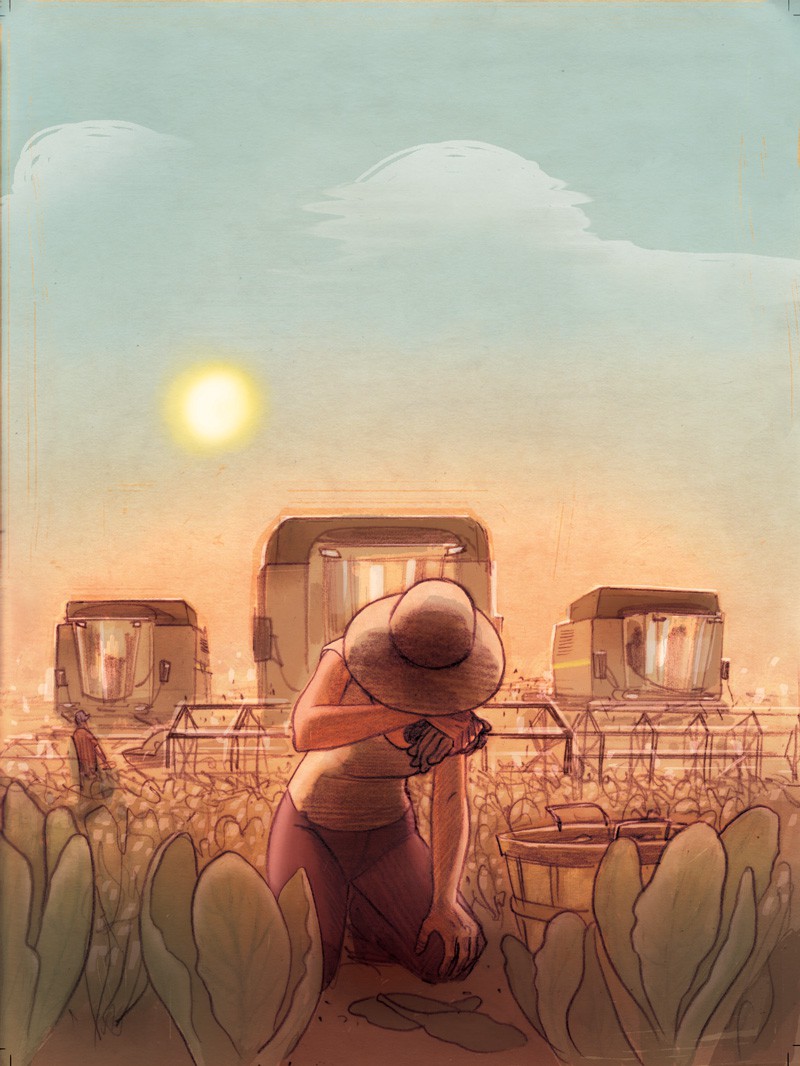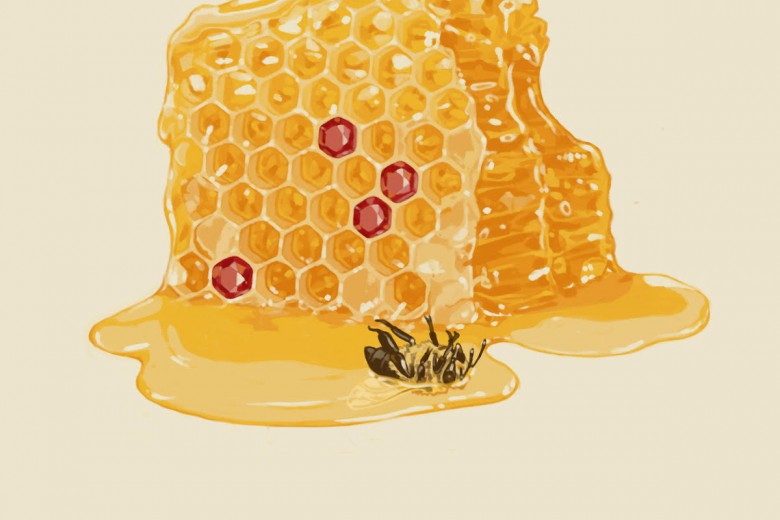
There are three things a farmer can’t live without: a wheelbarrow, a dog and a pry bar.” Maggie called this to me from just outside the barn, where she stood offering me the said pry bar. The dog looked up from where she lay lounging in the shade, and I paused where I crouched, preparing to heave a sizable boulder into the aforementioned wheelbarrow. I catalogued the wisdom for later reflection when out of the blazing midday sun, accepted the tool, and went back to my task of dislodging rocks from the soil beside the pasture.
I was Maggie’s WWOOFer. In other words, I was exchanging my labour for meals and accommodation on her small-scale, certified organic farm. WWOOF, which stands for World Wide Opportunities on Organic Farms, is a series of national organizations connecting organic farmers with volunteer labourers. It’s also used to refer to more informal arrangements like mine, which came about through word of mouth.
WWOOFing has continued to gain popularity over its 40-year history, largely because the exchange of labour for room and board is often mutually beneficial. WWOOFers can use the system as a way to travel inexpensively, or in my case, to learn about farming without making a huge investment in land or equipment. On the flip side, Maggie’s goal was to run a profitable small-scale organic farm, and she needed all the help she could find. Rather than pay cash wages, it made more sense for her to use the resources at hand: her existing farm infrastructure and the food she was already growing.
Our trade seemed a fair one. I was content to forgo an income since my primary objective was to learn, and because I had almost no expenses while I was there. In fact, I was excited to take a step away from the formal economy into a situation where my labour contributed directly to the fulfillment of my needs (i.e., food).
Ultimately, though, my WWOOFing experience inspired as many critical questions as sustainable solutions, which I had plenty of time to cultivate during my three-month stay on Maggie’s farm. Has small-scale organic agriculture become overly reliant on unpaid, underpaid and unregulated labour in order to remain financially viable? If so, can this be called sustainable?
Despite the ballooning popularity of organic, local and small-scale agriculture, the vast majority of food alternatives continue to operate within the assumptions of the capitalist model, which require that profit be the basis for food production. In fact, growing market demand puts additional pressure on small and organic farmers to increase efficiencies and meet their bottom lines at any cost, putting them at risk of compromising the human and environmental values at the heart of sustainable food production.
A dearth of farm workers
If you’ve ever spent time on a farm, you likely know that there is always more work that needs doing and almost always too few hours in the day to get it done. Simply put, farmers need farm workers. The Canadian Agricultural Human Resource Council (CAHRC) recently quantified this need, reporting in 2009 that “Canada’s primary agricultural producers expect to require an additional 50,000 non-seasonal and 38,000 seasonal workers by 2013.”
Though the CAHRC’s data is specific to larger farms, small farmers need workers all the same. In fact, in many cases, the smaller the farm, the greater the reliance on labourers. Add organic practices to the mix, and human power is even more necessary. Typically, small organic farms forsake the equipment and chemical inputs of conventional agriculture in lieu of greater human inputs. Large-scale equipment is generally impractical and unaffordable on a small farm, and fossil fuels, pesticides and chemical fertilizers are used differently, less, or not at all. While this can result in less efficient production by industrial agriculture standards, the benefits can include greater ecological sustainability and a price premium on the product.
While a few acres of garden don’t justify the expense of mechanized planting, cultivation and harvesting the way 1,000 acres might, a small farming operation won’t weed itself. For some, the increased need for human labour in small-scale and organic agriculture represents a huge opportunity. A 2006 report by the U.K.‘s Soil Association points out that 93,000 new jobs would be created if all farming in the U.K. were to go organic, with the added benefit of attracting new and young farmers to the land. Unfortunately, the same report failed to adequately address the underlying reasons behind labour challenges in agriculture, including domestic labour shortages, high cost of entry into farming, declining rural populations and disappearing farming knowledge and skills.
An informal economy
Farmers (both conventional and organic) meet their labour challenges in a variety of ways, depending on the scale and goals of their operation. On one end of the spectrum is the federal government’s Seasonal Agricultural Worker Program (SAWP), which is responsible for bringing in the more than 27,000 migrant workers that the Canadian agricultural industry relies on every year. On the other end, there are alternative arrangements such as WWOOFing, which don’t fall into the formal economy at all.
In between, there are a myriad of other possible arrangements. On Maggie’s farm, these included a handful of casual employees paid cash under the table, a Japanese woman travelling in Canada on a “farmstay” to learn English, unofficial WWOOFers like me, and of course Maggie herself, who worked alongside us day in and day out to keep her small operation afloat.
What all of these arrangements have in common is that the farm workers fall outside the purview of regular employment standards. In the case of SAWP, while the program operates within the formal economy, labourers do not enjoy citizenship rights and are exempt from many employment regulations. In arrangements like WWOOFing or farm internships, terms of employment such as wages, income tax, overtime and vacation pay are fluid, or simply don’t exist. In the U.S., this kind of unpaid farm labour is actually illegal and has recently drawn the attention of the U.S. Department of Labor, which has been cracking down on unpaid interns and volunteers on organic farms.
At Maggie’s farm, it was made clear that Maggie often worked 12-hour days, and that while six hours per day was the expectation for volunteers, there was plenty more work that could be done on an optional basis. In practice, living with Maggie in her home meant that volunteers were expected to work as she worked — as much as was necessary to get the job done. Starting and quitting times changed without notice, days off were not guaranteed, and extra work was delegated without requesting or receiving consent. Maggie herself certainly didn’t earn a living wage from her self-employed work as an organic farmer, a fact she regularly used as justification for expecting irregular and additional work from her unpaid workers.
When I eventually determined that my arrangement with Maggie was not what I had agreed to and no longer mutually beneficial, I had the language, finances and social capital to simply leave. Quitting, however, is not necessarily an option for the majority of farm workers. This is particularly true for people thousands of miles from home, who often face language barriers and threats of being blacklisted under programs like SAWP, and who are dependent on their farming income to support their families. Knowing this has challenged me to question my assumptions about what truly sustainable agriculture looks like.
Moving beyond profit
A major challenge in agriculture stems, as with most things, from the need to satisfy the bottom line. Farmers of any scale who rely on agriculture to provide income for themselves, their families and their workers are faced with the same fundamental problem — their revenue must exceed their expenses.
Balancing the books is becoming an increasingly difficult task for small- and large-scale farmers alike. According to the most recent Canadian Census of Agriculture, a whopping 71 per cent of Canadian farms with receipts less than $25,000 annually did not report enough farm income to cover their expenses, and nearly half of all Canadian farmers rely on off-farm income. This trend is even more dramatic in the U.S., where 65 per cent of farmers rely on off-farm employment.
Organic farmers are by no means immune to these pressures. While the burgeoning demand for ethically produced food should translate into a boon for small farmers who commit themselves to sustainable practices, market demand is not sufficient to resolve our society’s food challenges. From the production side, there is a limit to how much food can be sustainably produced on a small piece of land. At the farmers’ market Maggie attended, we regularly sold out of most of her food in the first couple of hours. Meeting the increasing demand would have meant putting more pressure on the land: inputting more fertilizers, working more hours and implementing more “efficient” practices. Producing more necessitates moving closer to the industrial model for growing food.
There is also a limit to the amount of small farming that can occur within the context of industrial agriculture. In Canada, farms just keep getting bigger, with an average size of 728 acres in 2006, up from 676 acres in 2001. During that period, the number of large farms increased by 14 per cent, while the number of smaller farms decreased by 11 per cent, according to Statistics Canada. In the U.S., although small farms make up 91 per cent of the country’s total farms, the fact remains that an incredible 75 per cent of U.S. agricultural production comes from only five per cent of total farms. No matter how many of us are supporting smaller farms, they still make up only a drop in the bucket of overall food production.
On the consumer side, regardless of how much demand there is for sustainably grown food, there is a limit to the costs that people are willing (or able) to bear. Our culture still expects food to be cheap, and even for those of us who do our best to source our food ethically, there is a price point that we are either unable or unwilling to cross. At Maggie’s farmers’ market stall, it wasn’t uncommon for customers to balk at the price, shop around for the cheapest deal, or haggle with us towards the end of the day. Though we may be willing to pay a bit more, sustainable food remains a luxury — there is still cheap food down the aisle or down the street or across town. And while small-scale organic producers can charge more, to a point, the premium may or may not be enough to translate into profit for the farmer.
All of these factors put constant pressure on food to achieve something that, by its nature, it is not designed to do — grow as fast and as reliably as the market demands. Farmer and writer Gene Logsdon puts it well: “Why is farming by its very nature unprofitable? The answer is easy, but no one will accept the implications. The way money grows is not the way plants, animals and humans grow. Corn or sheep grow at their own sweet rate, whether interest rates are 3 percent or 15 percent.”
Although 44 per cent of all Canadian farms don’t earn enough to cover their costs, according to the census, as a society of eaters we persist in our assumption that food production must be a profitable industry and that food itself must be a commodity. There are those of us who produce food for sale and those of us who consume food through purchase, and for most people, the two rarely meet.
What is sustainability? No really.
This “food as commodity” mentality severely limits our capacity to envision a truly sustainable food system. Conversations about sustainable food production are most often limited to growing practices; if they create a closed circuit that can continue indefinitely without depleting soil or water resources, we consider them sustainable. If such practices produce the necessary yields to meet the nutritional needs of the people who rely on the land for their food, even better.
Sometimes these discussions extend to the financial sustainability (i.e., profitability) of a farm operation. Can the farmer’s revenue consistently outpace their expenses, and can they comfortably support themselves and their families through their farm income? If not, is the balance between on-farm and off-farm work reasonable, or will it ultimately lead to burnout, debt or bankruptcy? From the consumer’s perspective, is sufficient nutritious food available at a cost that people can reasonably afford?
Beyond environmental and financial considerations, there are also the social and ethical implications of sustainable agriculture. Can farming be practiced in a way that is socially just and treats people as humans first, and labourers second? Are farm workers being fairly compensated? Ethical questions extend to the treatment of other beings as well. How are animals used, and is their treatment humane as well as sustainable?
As farmers, farm workers, gardeners, locavores, policy-makers and eaters, we need to begin engaging in a holistic conversation in which all of these interconnected questions are considered. The necessary framework already exists in the International Federation of Organic Agricultural Movements’ (IFOAM) four principles of organic agriculture, which include the principles of health, ecology, fairness and care. “The principles are to be used as a whole” states the IFOAM website. “They are composed as ethical principles to inspire action.” We simply need to act.
And in many ways, we are. More and more of us who were previously relegated to the role of consumer are getting involved with producing our own food. We are growing gardens, keeping chickens, and finding countless ways to provide food for ourselves outside of the formal economy. The more food we grow ourselves, the more we understand that food is not inherently a commodity. This allows us to better understand and support the farmers who make their living growing our food. Producing food also allows us to provide for our own sustenance directly and to begin to step away from the assumptions that everything begins and ends with our ability to earn money.
Our booming interest in sustainable food provides us with an unprecedented opportunity to revolutionize our food systems and redefine the role that food plays in all of our lives. But by treating food only as a commodity, we risk missing the point entirely, leaving sustainable agriculture as vulnerable to the whims of the bottom line as any other industry.






